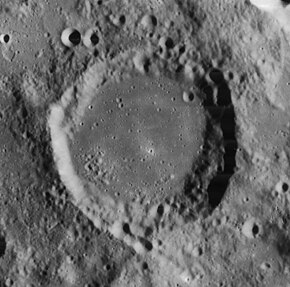Abulfeda is a lunar impact crater located in the central highlands of the Moon. To the northeast is the crater Descartes, and to the south-southeast is Almanon. To the north is the crater Dollond. A chain of craters named the Catena Abulfeda runs between the southern rim of Abulfeda and the north rim of Almanon, then continues for a length of 210 kilometers across the Rupes Altai. The crater was named for 14th century Kurdish historian Ismael Abul-fida.[1][2][3][4][5][6]
 Lunar Orbiter 4 image | |
| Coordinates | 13°48′S 13°54′E / 13.8°S 13.9°E |
|---|---|
| Diameter | 62 km |
| Depth | 3.1 km |
| Colongitude | 346° at sunrise |
| Eponym | Ismael Abul-fida |


NASA Image
Both the south and northeast sides of the crater rim are overlain by multiple small craterlets. The inner wall is noticeably wider in the east, and shallow and worn to the north. The crater floor has been resurfaced, either by ejecta from the Mare Imbrium or by basaltic lava, and is relatively smooth and featureless. The crater lacks a central rise at the midpoint, which may have been buried. The inner sides appear to have been somewhat smoothed down, most likely as a result of minor bombardment and seismic shaking from other impacts in the vicinity.[6][7]
Abulfeda is a crater of Nectarian age.[8]
A crater chain along the southern rim of Abulfeda was considered for a landing site of an early Apollo mission, primarily because it was considered to be a typical highland site, and at the time, crater chains were thought to possibly be volcanic in nature (rather than of impact origin).[9]

Satellite craters
editBy convention these features are identified on lunar maps by placing the letter on the side of the crater midpoint that is closest to Abulfeda.[10]
| Abulfeda | Latitude | Longitude | Diameter |
|---|---|---|---|
| A | 16.4° S | 10.8° E | 14 km |
| B | 14.5° S | 16.4° E | 15 km |
| BA | 14.6° S | 16.8° E | 13 km |
| C | 12.8° S | 10.9° E | 17 km |
| D | 13.2° S | 9.5° E | 20 km |
| E | 16.7° S | 10.2° E | 6 km |
| F | 16.2° S | 13.0° E | 13 km |
| G | 13.1° S | 9.0° E | 7 km |
| H | 13.8° S | 9.6° E | 5 km |
| J | 15.5° S | 10.0° E | 5 km |
| K | 14.9° S | 10.6° E | 10 km |
| L | 14.1° S | 10.7° E | 5 km |
| M | 16.2° S | 12.1° E | 10 km |
| N | 15.1° S | 12.2° E | 14 km |
| O | 15.4° S | 11.2° E | 7 km |
| P | 15.5° S | 11.5° E | 5 km |
| Q | 12.8° S | 12.3° E | 3 km |
| R | 12.8° S | 13.0° E | 7 km |
| S | 12.2° S | 13.3° E | 5 km |
| T | 14.8° S | 13.8° E | 7 km |
| U | 13.0° S | 13.8° E | 6 km |
| W | 12.5° S | 13.9° E | 5 km |
| X | 15.0° S | 14.0° E | 6 km |
| Y | 12.8° S | 14.1° E | 5 km |
| Z | 14.7° S | 15.2° E | 5 km |
References
edit- ^ "Abulfeda". Gazetteer of Planetary Nomenclature. USGS Astrogeology Research Program.
- ^ "Biographical Dictionary of the Archival and Documentation Site on Muslims". Archived from the original on 10 September 2010. Retrieved 1 September 2012.
- ^ Abu-al-Fida at Encyclopaedia Britannica
- ^ Helaine Selin (1997). Encyclopaedia of the History of Science, Technology, and Medicine in Non-Western Cultures. Netherlands: Springer Science & Business Media. pp. 7–8. ISBN 978-0-7923-4066-9.
- ^ Identifiants et Référentiels Sudoc Pour L'Enseignement Supérieur et la Recherche - Abū al-Fidā (1273-1331) (in French)
- ^ a b Autostar Suite Astronomer Edition. CD-ROM. Meade, April 2006.
- ^ Moore, Patrick (2001). On the Moon. Sterling Publishing Co.. ISBN 0-304-35469-4. p.207
- ^ The geologic history of the Moon. USGS Professional Paper 1348. By Don E. Wilhelms, John F. McCauley, and Newell J. Trask. U.S. Government Printing Office, Washington: 1987. Table 9-4.
- ^ El-Baz, Farouk, 1968. Geologoic Characteristics of the Nine Lunar Landing Mission Sites Recommended by the Group for Lunar Exploration Planing. Bellcomm, Inc. TR-68-340-1.
- ^ Bussey, B.; Spudis, P. (2004). The Clementine Atlas of the Moon. New York: Cambridge University Press. ISBN 0-521-81528-2.
External links
edit- Abulfeda at The Moon Wiki
- Catena Abulfeda at The Moon Wiki
- Boulder or Crater? - Lunar Reconnaissance Orbiter page with images
- Wood, Chuck (14 April 2005). "Boo! (Really Bu!)". Lunar Photo of the Day. Archived from the original on 12 February 2018. Retrieved 10 October 2017.
- Wood, Chuck (5 November 2006). "Not Quite A Rille". Lunar Photo of the Day. Archived from the original on 14 June 2011.
- Wood, Chuck (8 November 2006). "A Very Good Humility Lesson". Lunar Photo of the Day. Archived from the original on 14 June 2011.